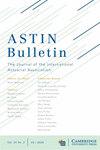Risk sharing in equity-linked insurance products: Stackelberg equilibrium between an insurer and a reinsurer
IF 1.8
3区 经济学
Q2 ECONOMICS
引用次数: 2
Abstract
Abstract We study the optimal investment-reinsurance problem in the context of equity-linked insurance products. Such products often have a capital guarantee, which can motivate insurers to purchase reinsurance. Since a reinsurance contract implies an interaction between the insurer and the reinsurer, we model the optimization problem as a Stackelberg game. The reinsurer is the leader in the game and maximizes its expected utility by selecting its optimal investment strategy and a safety loading in the reinsurance contract it offers to the insurer. The reinsurer can assess how the insurer will rationally react on each action of the reinsurer. The insurance company is the follower and maximizes its expected utility by choosing its investment strategy and the amount of reinsurance the company purchases at the price offered by the reinsurer. In this game, we derive the Stackelberg equilibrium for general utility functions. For power utility functions, we calculate the equilibrium explicitly and find that the reinsurer selects the largest reinsurance premium such that the insurer may still buy the maximal amount of reinsurance. Since in the equilibrium the insurer is indifferent in the amount of reinsurance, in practice, the reinsurer should consider charging a smaller reinsurance premium than the equilibrium one. Therefore, we propose several criteria for choosing such a discount rate and investigate its wealth-equivalent impact on the expected utility of each party.股票挂钩保险产品的风险分担:保险公司和再保险公司之间的Stackelberg均衡
摘要研究了股票挂钩保险产品下的最优投资再保险问题。此类产品通常有资本担保,这可以激励保险公司购买再保险。由于再保险合同隐含着保险人和再保险人之间的相互作用,我们将优化问题建模为Stackelberg博弈。再保险公司是博弈中的领导者,通过选择其最优投资策略和提供给保险人的再保险合同中的安全负荷来最大化其预期效用。再保险人可以评估保险人将如何对再保险人的每一个行为作出理性反应。保险公司是跟随者,根据再保险人提供的价格选择投资策略和购买再保险的数量,从而实现预期效用的最大化。在这个博弈中,我们推导了一般效用函数的Stackelberg均衡。对于幂效用函数,我们明确地计算了均衡,发现再保险人选择最大的再保险保费,使得保险人仍然可以购买最大的再保险金额。由于在均衡状态下,保险人对分保金额无所谓,在实践中,再保险人应考虑收取比均衡状态下更低的分保保费。因此,我们提出了选择这样一个贴现率的几个标准,并调查其对各方预期效用的财富当量影响。
本文章由计算机程序翻译,如有差异,请以英文原文为准。
求助全文
约1分钟内获得全文
求助全文
来源期刊

ASTIN Bulletin
数学-数学跨学科应用
CiteScore
3.20
自引率
5.30%
发文量
24
审稿时长
>12 weeks
期刊介绍:
ASTIN Bulletin publishes papers that are relevant to any branch of actuarial science and insurance mathematics. Its papers are quantitative and scientific in nature, and draw on theory and methods developed in any branch of the mathematical sciences including actuarial mathematics, statistics, probability, financial mathematics and econometrics.
 求助内容:
求助内容: 应助结果提醒方式:
应助结果提醒方式:


